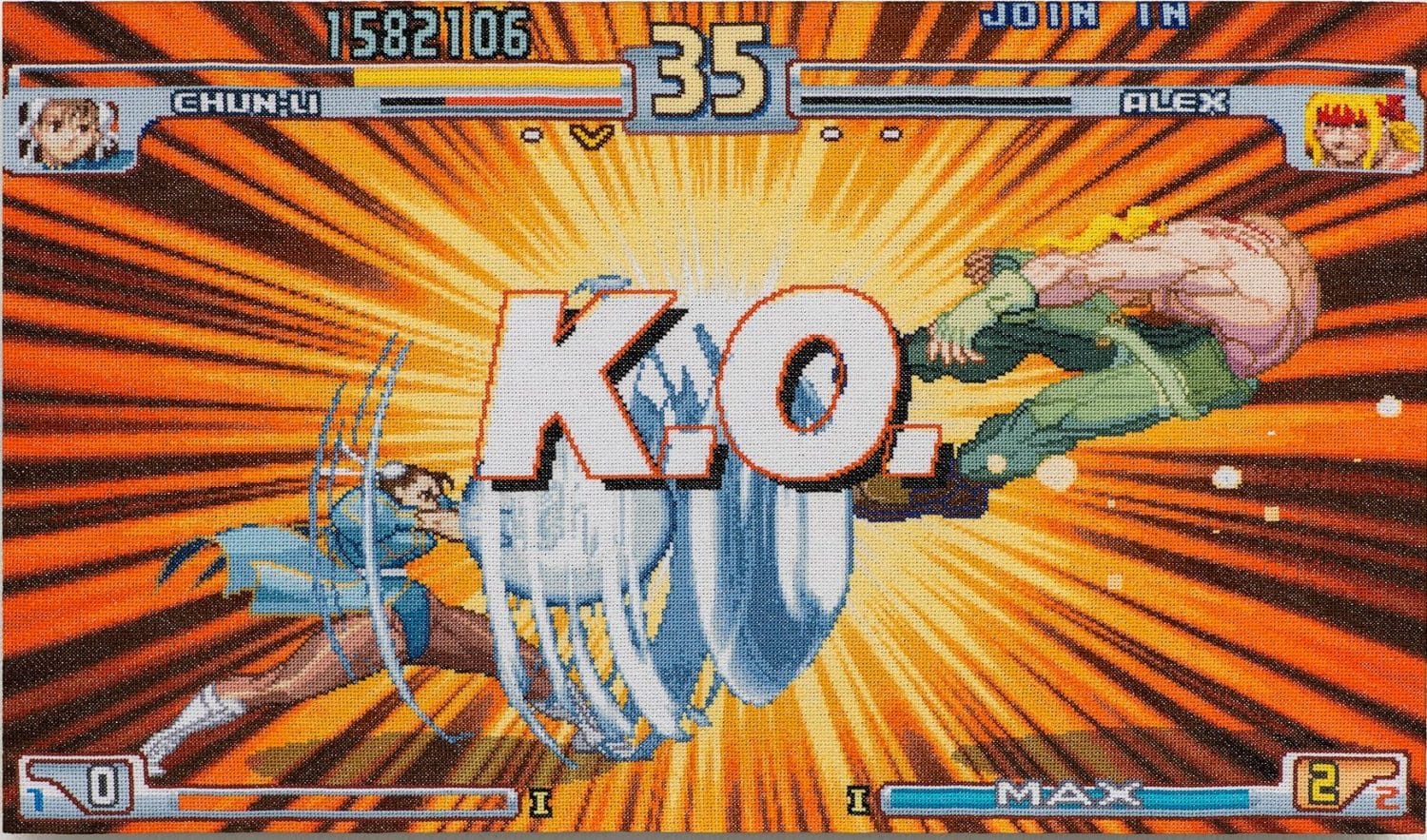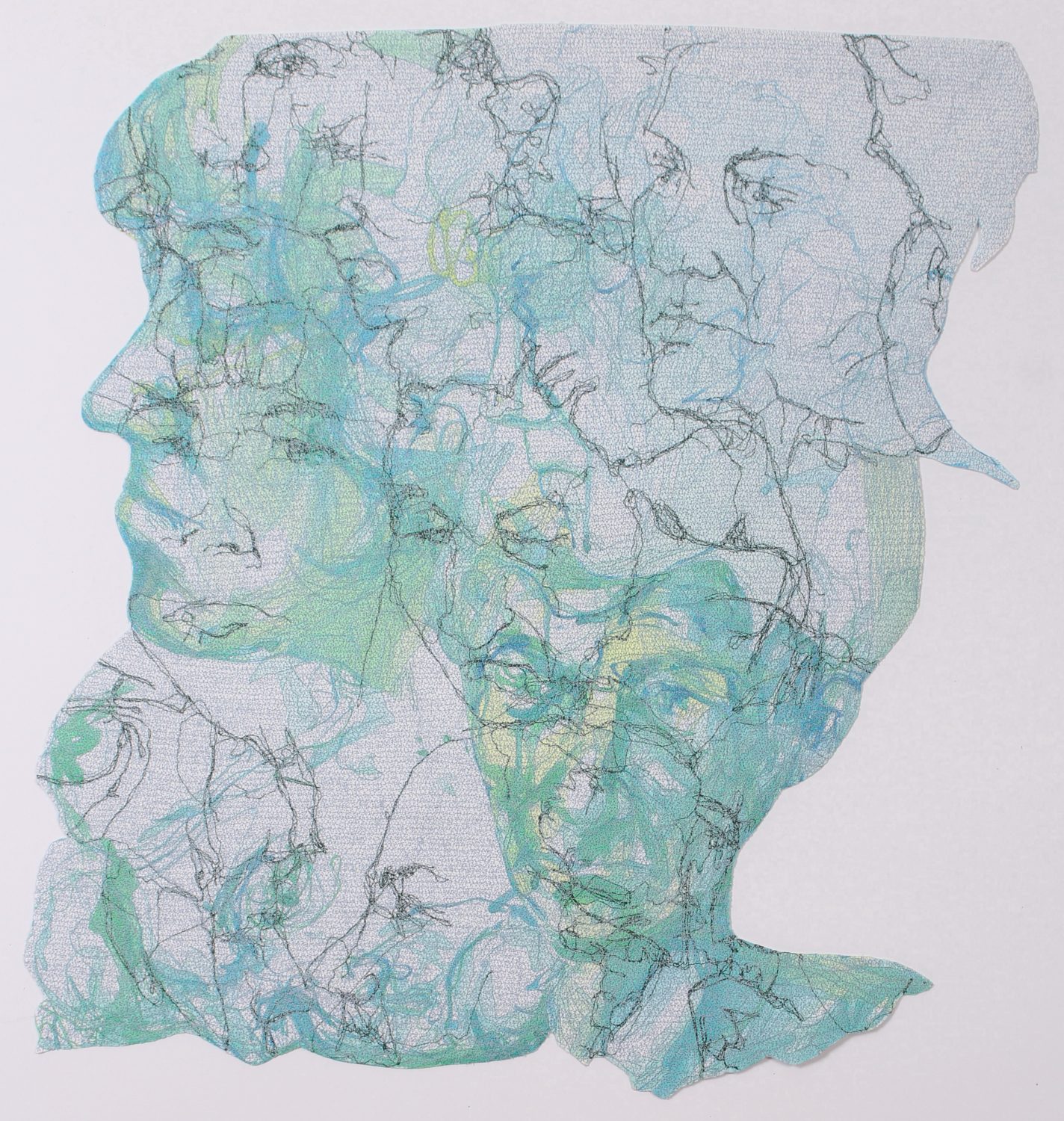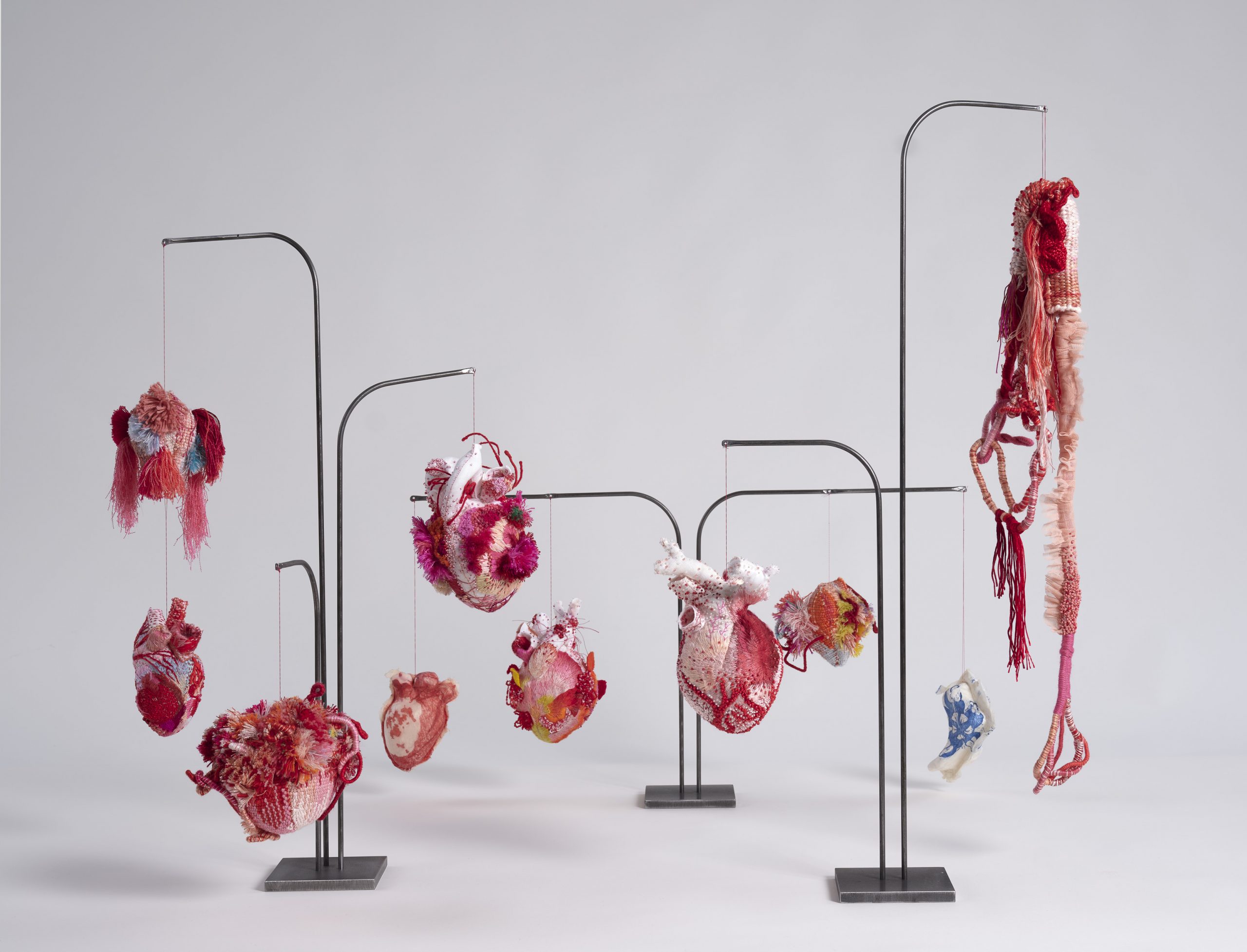Per Fhager is a Swedish needlepoint artist whose large scale hand stitched tapestries recreate video game scenes from his past.
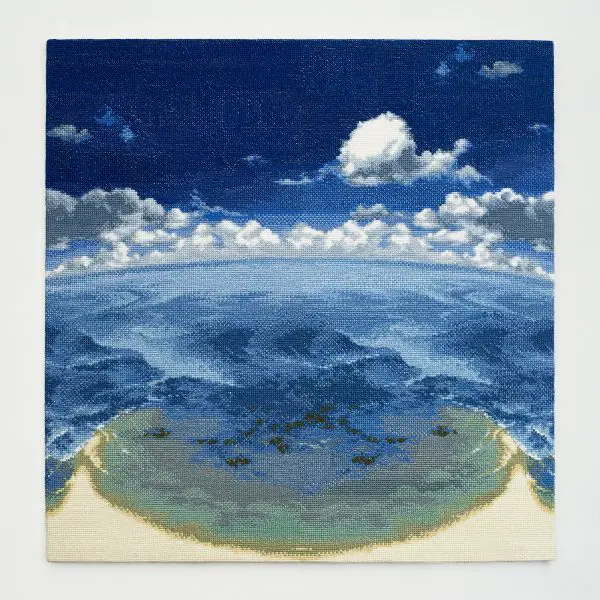
How did you come to be an embroiderer?
I have always been a maker, doing things, creating things. I have always worked with my hands, it has always been the way I express myself, and where I find strength and inspiration. Textile craft has been a part of me for as long as I can remember, ever since the textile craft classes in school. The colours, the yarns, feeling the material. Crochet, sewing, knitting and needlework. I have a textile and fashion education; I can sew clothes. During my studies I reconnected with embroidery and implemented it in my collections.
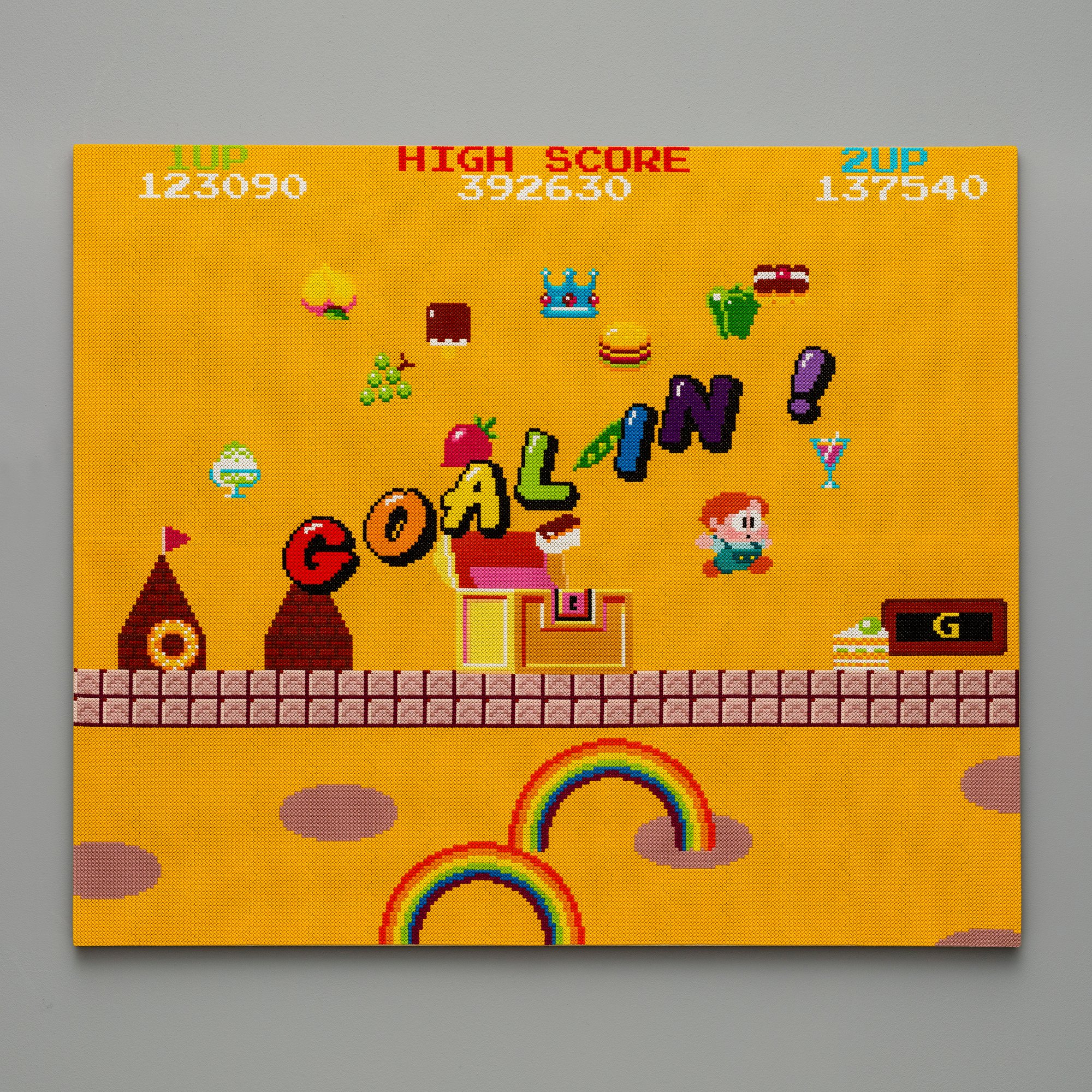
What does it mean to you?
Needlepoint is a quite old craft, working with an old craft makes me aware that I’m in some way carrying a part of history. At the same time, I also want to challenge conventions, and do it my way. I don’t want to play by the rules. Seeing how my work connects with one hundred years old tapestries is humbling.
Everyone who approaches a craft will eventually start doing it their own way. That is the only way we can evolve it. The needlepoint medium is also a way to create permanence. Today many images and media are transient, flickering away and then last forever. Out of sight, out of mind. Using a time-consuming craft, such as needlepoint, is a way to capture these images, making them permanent.
No matter what you think of needlepoint, or witch associations it brings, you cannot deny that it is there. Textile works take a lot of space, not just physical but also emotional. There is so much depth and texture that they demand their space. They have a life of their own, these works.
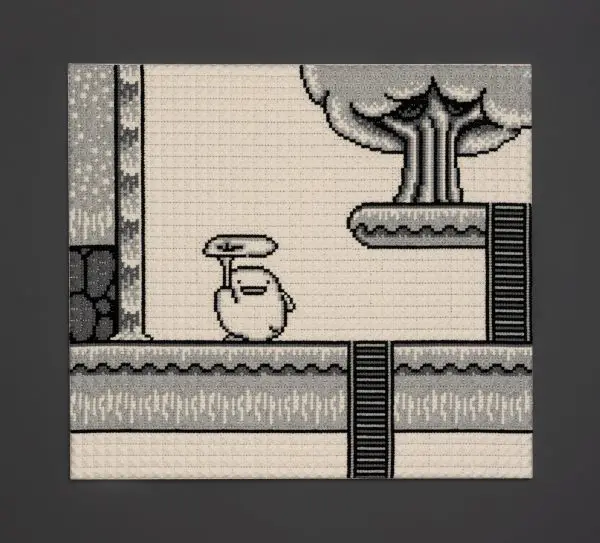
Where do you like to work?
For the past years I’ve been very productive, creating a multitude of works for various exhibitions. So, it has been some time since I did needlepoint casually. Now, it’s all about getting things done. I work in my studio, and I usually work from home as well.
It is vital for me to have several works in progress at the same time. It makes me feel like I’m moving forward, which is especially important since this craft is quite time consuming. I always have to create the illusion of me getting more things done then I might actually be doing. It’s all about mind games, to get things done. Fooling myself.
I’ve done this for more than 10 years now, so I have found my ways to ease this process. It sounds like I don’t appreciate it anymore, but I actually really, really love doing this. If my heart is not in it, I would not be able to do it. It is just too many hours spent.
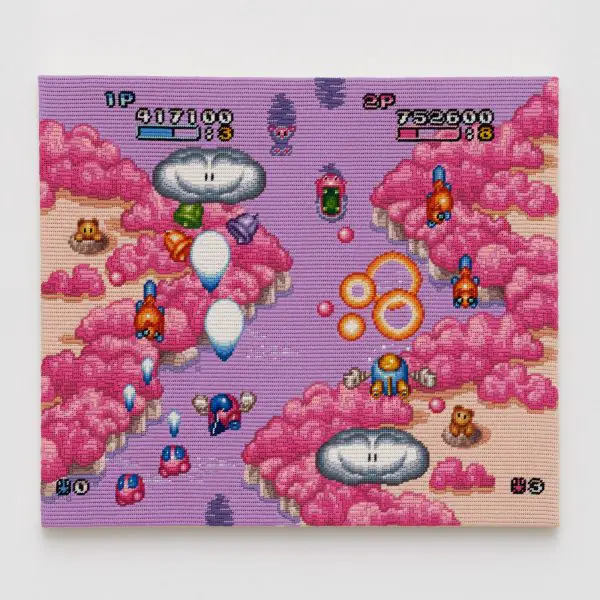
How do people respond to you as a male embroiderer?
For as long as I can remember, I have always found myself being the odd one out no matter where I ended up. I’m so used to that that I don’t really think about it at all.
The imagery I work with in my art is so different, that it sort of takes focus from me as a person. And I don’t really mind that, it’s actually pretty nice. I don’t really strive to be the centre of attention. I want the focus to be solely on my art.
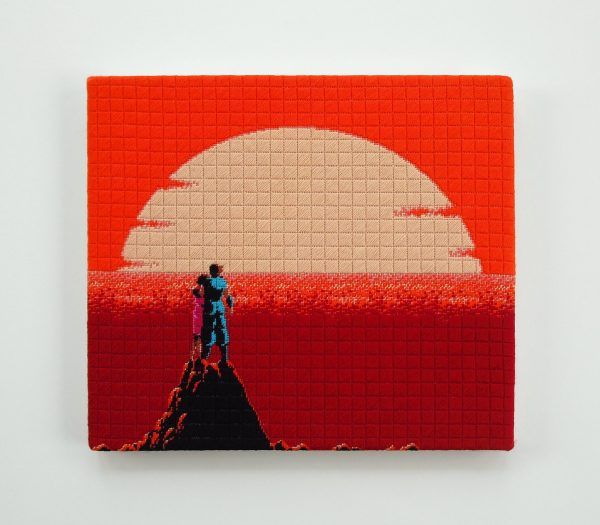
But I must admit that there is a part of me that feels I have to prove myself, being a minority within this field. I believe anyone who has been in a similar situation, has felt this way. So, in that sense I’m very grateful for that, because it has pushed me to reach my goals, and never be content.
I have a designer background; I’ve been working for commercial businesses for many years. The art world is a haven in many ways, because it allows you to be your true self, more or less. Actually, people expect that from you being an artist. So sometimes I feel that I might be a bit too boring, or plain for an artist. That people expect a more eccentric person. I think in my case my work is the eccentric part, and that’s what matters to me.
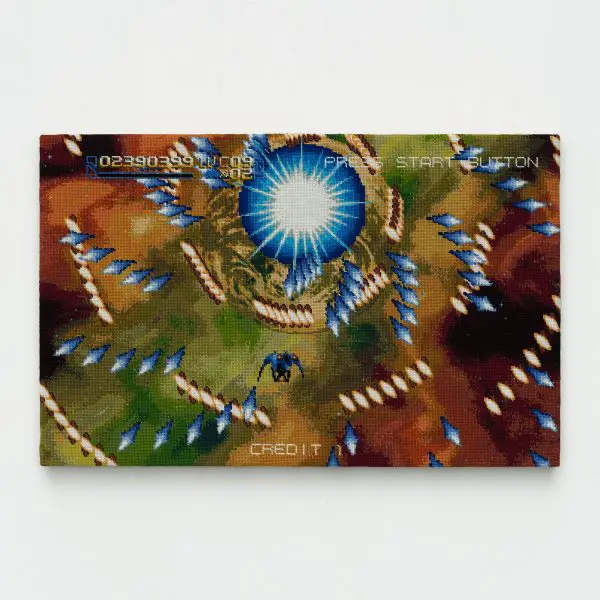
Who inspires you?
I was lucky enough to grow up with Kaffe Fassett books in the family library. Kaffe Fassett is an American British textile artist. He works in many different mediums including needlepoint. The way he approaches this medium has always been an inspiration to me. He has always done it his own way.
Even though our aesthetics are of course very different, I feel that we in some way share the same rebellious nature towards this craft. Seeing his grand needlepoint works made me believe in myself and the fact that it was physically possible to do this. It made me open up to the idea of making my largest size works. I’m not sure I would have attempted that without the inspiration of Kaffe Fassett.
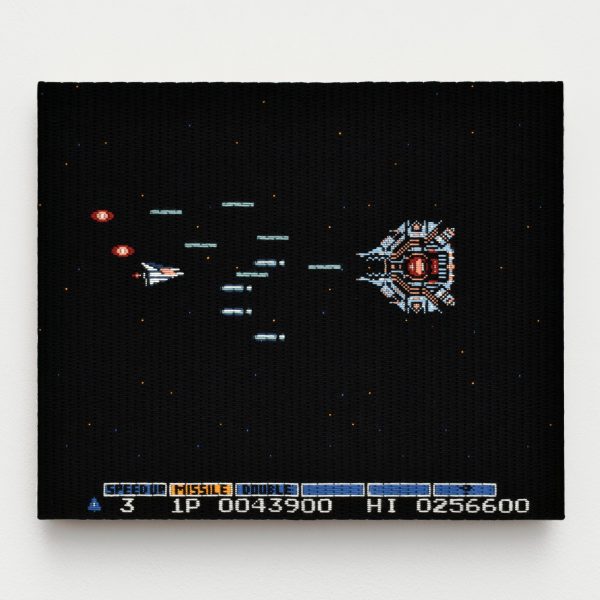
How or where did you learn you learn how to stitch or sew?
In Sweden we have textile craft classes in school. That is quite unique in the world, and I am so grateful for that. At least when I was in school, they taught different stitches and different threads. That was my first contact with needlepoint. After that, I’ve taught myself to do this.
I love reading old literature about this subject. Especially books from the 70s, an era when needlepoint had a huge revival. Everyone was doing it. The good thing about needlework, working on canvas, is that it is not that hard to do the actual stitches. You just follow the grid, and the holes in the canvas. The challenging part is to have the stamina to fulfil the project. And maybe also to keep an even thread tension… But to me, that’s about it.
My needlepoint library is my treasure tomb. Right now I live in the southern part of Sweden where the long-legged cross stitch or tvistsöm originates. When you go to second hand shops here in, you can always find these long-legged cross stitch works. I love this stitch and it makes me especially happy, being a part of this local history, doing these stitches in this particular geographic location.
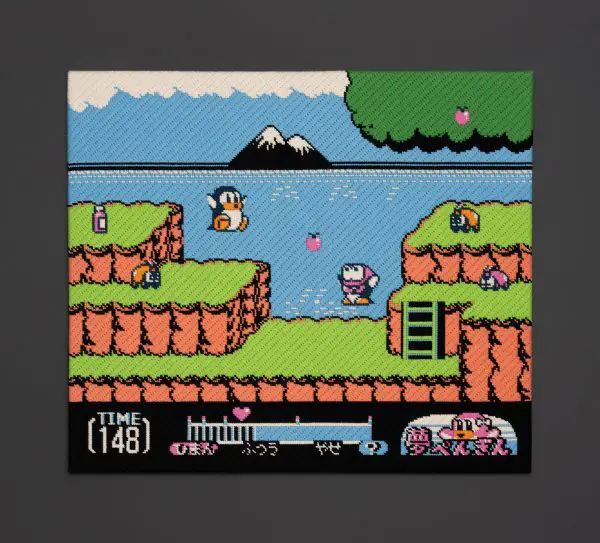
Are your current images new ones or have you used them before?
I love video games, but I don’t love all video games. Sometimes people ask me if I could do this or that game, games I’ve never played. But I have to be emotionally attached, otherwise I cannot do it. And I find myself being unable to even think about it.
When you look at my body of works for the past ten years, you’ll see that some games reappear. These are the games that means so much to me, that I cannot just let them go. There’s so much I want to share, that one image is not enough. Of course, I never repeat the exact same image. …now when I think about it, it might be a cool idea for an exhibition… But, at least up until this point, I always strive for novelty.
I want to repeat myself to prove my point and conceive my message, but at the same time I don’t want to be predictable. But since I’m doing the same thing over and over, I think I am a bit predictable. And that actually predictability is a part of my artistry.
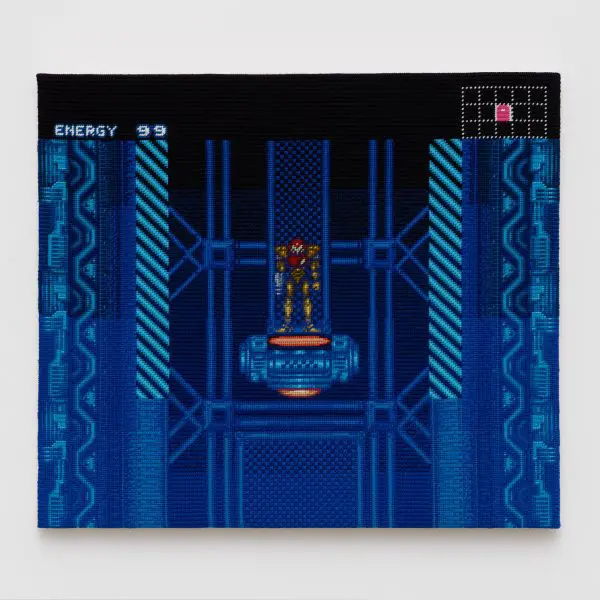
How has your life shaped or influenced your work?
When I started doing needlepoint I did it for myself. I know I loved these games, and I knew I wanted to do the craft, but that was about it. I did not have any deeper thoughts about it at that time. It has been like that for many years, until recently where I have been able to put words on this process a bit more.
It has been clear to me that these games that I do, connect to certain parts of my young life. Some of these times has been challenging to me, and it is quite clear that I have found it difficult to approach those particular games because they remind me of certain experiences in life. I love these games so much, so I refuse to let these memories interfere with my creativity.
Video games were the perfect escape for me. During my parents’ divorce I brought my GameBoy console out in the forest and played the Legend of Zelda links awakening. Escaping into these games brought relief during my teenage years. Of course, there are also games that I only associate with happy feelings. Like the early 8-bit Nintendo Entertainment System games, where we gathered around the TV on the floor, with my friends, playing Bubble Bobble or Ice Climber. Those were joyous occasions that I truly cherish.
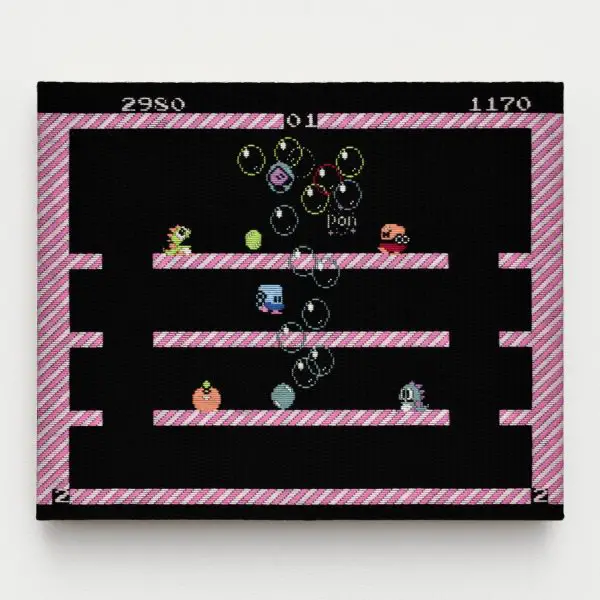
What are or were some of the strongest currents from your influences you had to absorb before you understood your own work?
When I first came in contact with video games in the early 1980s, like most people I knew, I grew up with western animation and illustration. I immediately was drawn to these video games, but I did not know why. I could see that the design was different and that the worlds had different references. I now know, it was because these video games became my first contact with Japanese popular culture.
I’ve always been drawn to Japanese culture. And back in the 90’s, anime and manga was not that common in the West as it is today. So, everything was kind of hard to get a hold of. And I think that also made it even more fascinating. I only do images from Japanese games.
My latest exhibitions revolve around many games that have never been released outside of Japan. Often these unreleased games are the most Japanese ones, so to speak. Many times, the games were so culturally specific that they did not believe that they could sell them in the West. And that is what I love about them.
I have studied Japanese a bit, I’ve been doing origami for years and years, and I love Japanese movies. The way that Japanese culture almost always puts technology and nature together on the forefront is what I love about this culture. It is a blend of old and new, just like my art.
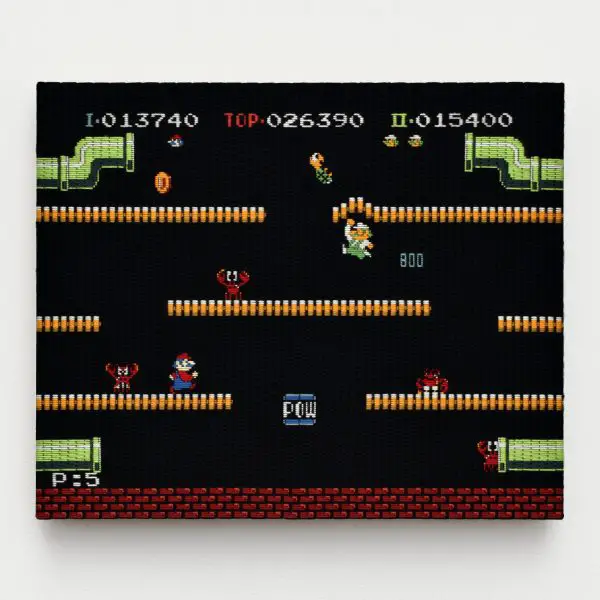
Do formal concerns, such as perspective and art history, interest you?
I have a designer background, so I am used to do doing research and looking up references when working creatively. I know art history on a top level. And I think it is really exciting to hear people with deeper historic knowledge sometimes seeing, or not seeing, parallels between classic artist movements and the works I do.
I love the romantic era of paintings, that was especially prominent in Europe and the Nordic countries at the time. Video game graphics are usually perceived as quite kitschy, just like the romantic era, to some extent. I also think it is interesting to see the references that the creators of these video games had. Once you start looking, that references are everywhere.
So, when I do a needlepoint of an old video game, I am referencing something that might be referencing something else. Furthermore, Western references specifically, are being filtered through the Japanese popular culture. So, there is a lot of layers, and I find that really interesting. But I am not an art historian. I’ll leave that up to other, wiser people to make those connections.
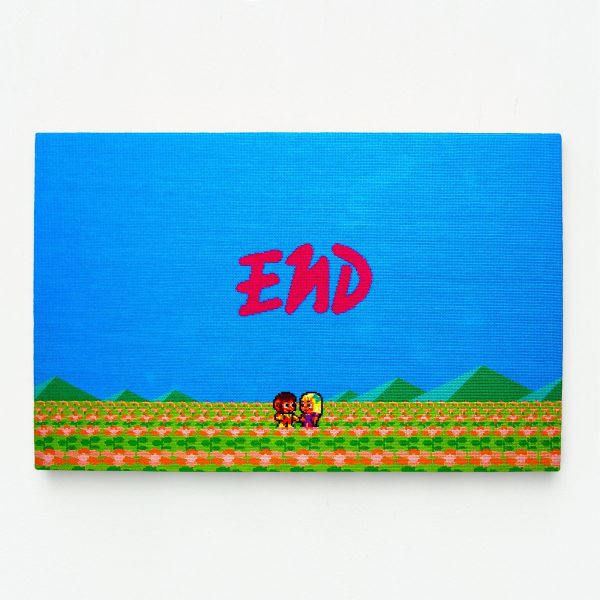
What do your choice of images mean to you?
It is important for me to convey the unique energy found in video games. It’s ironic, because video games are all about motion. And my images are static stills. Even though I compose the images myself, the screenshots still have to be true to the original games.
Sometimes I meander into dark murky images from games. But I have learnt over the years that it is the bright colourful or strikingly contrasting works that have the largest impact. More so actually, than familiar characters. It is all about the images. It should also be a clear distinction between the characters and the background.
I want people to be able to decode my images, without having any prior knowledge of video games. Or needlepoint for that matter. That is why I’m looking for emotion or scenery or mood or colour, when I select the images, I want to do.
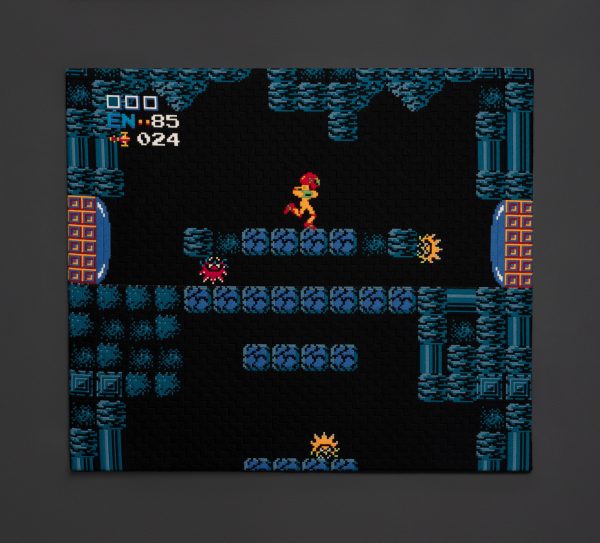
In the beginning my works were quite busy, but then I ventured into more minimalistic works. Especially the early video games that were unintentionally minimalistic, due to hardware constraints. I always set up boundaries and weird rules for myself when working creatively. That is how I function, I guess.
In my newest works I have “allowed” myself to crop characters outside the frame. It sounds like the silliest thing, but before I was forced, by myself, to keep everything within the frame of the picture. But now, I can put half a character outside of the frame, if you get my meaning. And this really helps conveying a sense of motion. That things are approaching or leaving the screen. So sometimes these rules, they don’t help at all.
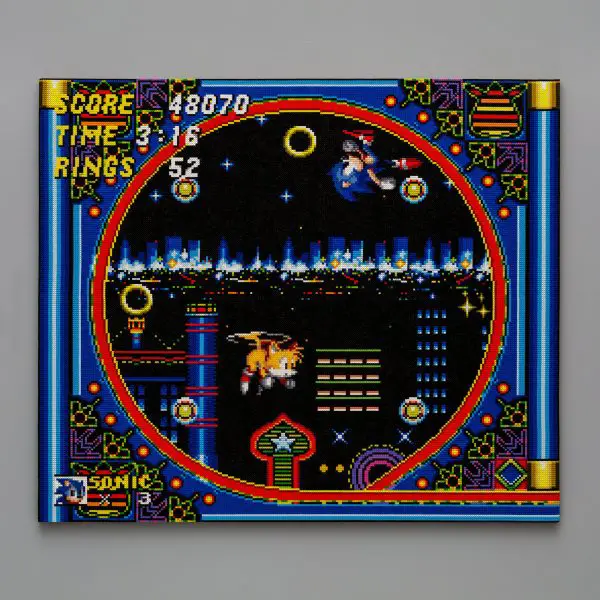
Do you look at your work with an eye toward it like what can and can’t be visually quoted? In other words what you will or won’t cut out?
Because I am an illustrator, and I have been drawing a lot in my professional work as well as for myself. The composition of these images is really important to me. I have learnt that if there is no character making contact with the viewer, the image kind of dies, in most cases. Unless there is some connection between the characters in the image.
Games that look really good on screen might sometimes not work at all as a needlepoint work. Also, some things that I love in my mind, don’t convey that same sense at all, when being converted into needlepoint. So, I really try to look at all the works I’m working on simultaneously to see how they complement each other. And if one picture does not cut it, I will take it out for.
Sometimes rejected ideas become recycled or born again in new projects, in new settings. I go back to old ideas a lot. So, it is all about the current context, and my current mood as well.
There was a part of my artistic career when I had left my full-time job, to focus on the art full time. It sounds really amazing, but what actually happened was that it became too much. I sort of lost my spark, and my artistry became mechanical. I made some cool pictures at the time, like Metal Slug, but when I look at them now. They are all kind of murky and brown, and that really conveyed my mood at the time. So, the following years I really strived to get back to the initial excitement I had when started doing this, more than ten years ago.
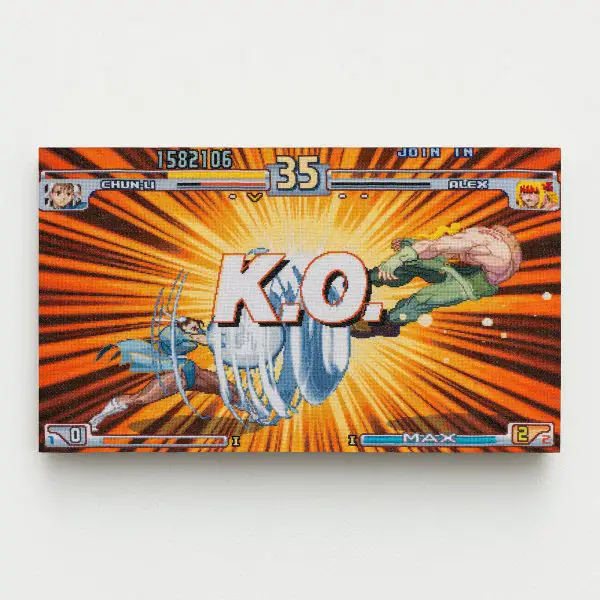
Do you have any secrets in your work you will tell us?
Some games I make needlepoint work of, I have never played. I just love the images. Like the piece I made from Street Fighter III. It is a game with amazing character designs, that I just had to do something with. But fighting games are not my cup of tea. I am really, really bad at them. I basically suck. You have to put in these advanced button combinations, in order to perform cool attacks. So, the frame that you see is basically just me putting in this command over and over in the computer to get the result I wanted, not me actually playing the game. And you can tell by my score that is quite low, I think.
Also, a piece I made from another game called Ikaruga. It is a shooting game from the bullet hell genre. These games are super complex and ultra difficult. It is sort of the charm about them. But I can barely beat the first stage without dying in that game. But the imagery is so amazing, that I had to do it anyway.
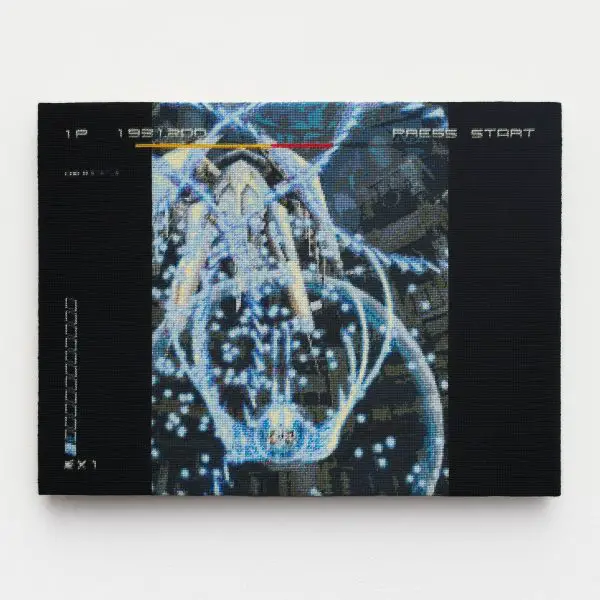
How do you hope history treats your work?
No matter if you love or hate or feel completely oblivious to what I do, I still hope and want that people will have some sort of opinion about my works.
The good thing about needlework, or craft in general, is that you cannot deny its existence. You cannot brush it away. If someone is provoked that I am using unconventional imagery, I have succeeded. If someone feels that my art is too shallow, I have succeeded. As long as I get a reaction.
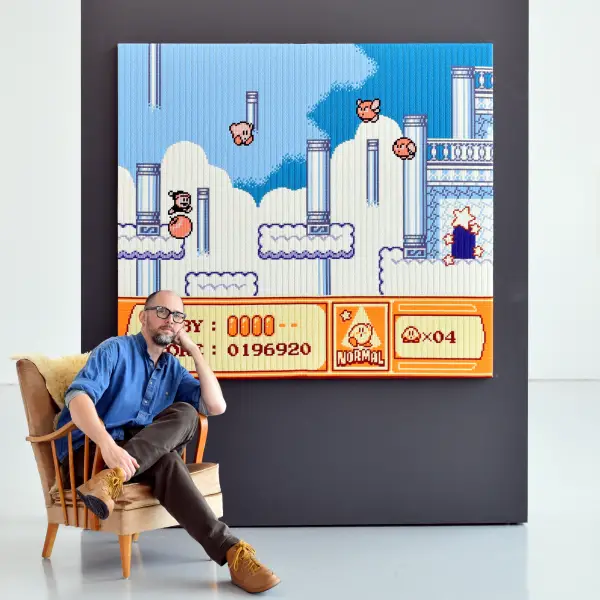
What I hope is that at least my works will put some light on these early video games. The people developing these games in the 80’s and 90’s were pioneers. Now video gaming is quite huge all over the world, but at that time it was still a quite new phenomenon. I believe that in time, video gaming as a cultural medium will be appreciated more and more. And not just the most famous games, but also the obscure ones. If I can be a part of that, I’m very happy.
I also hope that my needlepoint work at the same time will shed some light, on this craft. I believe more people would be happy your if they worked a little bit more with their hands. I believe that is something we just inherently need to do.
Where can we find you and your work?
My website is perfhager.com, you can find me on Instagram and on YouTube. I have upcoming solo exhibitions at Jönköpings Läns Museum, Jönköping, Sweden (September-November 2023) and Gävle Konstcentrum, Gävle, Sweden in Spring 2024.

